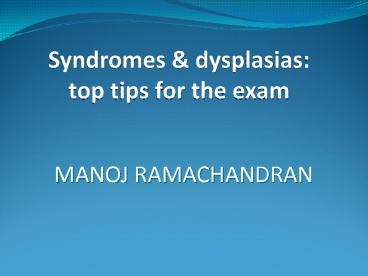Syndromes - PowerPoint PPT Presentation
1 / 24
Title: Syndromes
1
Syndromes dysplasias top tips for the exam
- MANOJ RAMACHANDRAN
2
Syndromes
3
Diagnostic criteria for neurofibromatosis
CAFE SPOT Cafe-au-lait spotsAxillary or
inguinal freckling (Crowes sign) Fibroma
(neuro)Eye Lisch nodulesSkeletal involvement
(e.g. bowing)Positive family historyOptic
Tumour (glioma)
4
NF questions
- Skeletal manifestations
- Dystrophic/non-dystrophic scoliosis
- Segmental hypertrophy
- Treatment of CPT
- ?Bracing
- Excision, grafting and compression with external
fixation/intramedullary fixation - Amputation (for functional salvage)
5
Marfans syndrome MARFANS Mitral valve
prolapse Autosomal dominant / Arched palate
(high) / Aortic aneurysm / Aortic regurgitation /
Acetabular protrusion Retinal detachment and
superior dislocation of the lens Fibrillin
mutation on chromosome Fifteen Arachnodactyly Nega
tive nitroprusside test (differentiates Marfans
from homocystinuria) Scoliosis /
Spondylolisthesis / Slack joints (ligamentous
laxity) / Spontaneous pneumothorax / Striae
atrophicae (stretch marks)
6
Dysplasias
7
Basic principles
- History
- Full
- Development
- Examination
- Complete
- Height / Weight
- Investigations
- Appropriate
8
Segmental shortening
- Where is the abnormality?
- Rhizomelic proximal
- Mesomelic - middle
- Acromelic - distal
- Phocomelic
- Thalidomide
9
Investigations
- Skeletal Survey
- Lateral skull / other views
- Lateral whole spine
- PA chest
- AP pelvis
- Whole 1 leg
- Whole 1 arm
10
Making a diagnosis
- Metaphyseal
- Dysplasia
11
Making a diagnosis
- Epi - physeal
- Metaphyseal
- Dysplasia
12
Making a diagnosis
- Platyspondyly
- Spondylo -
- Epi-metaphyseal
- Dysplasia
13
But then it lets you down
Acro mesomelic dysplasia!!
14
From Ramachandran (ed). Basic Orthopaedic
Sciences The Stanmore Guide
15
Trevors disease (dysplasia epiphysealis
hemimelica)
TREVOR Tarsal bones and knee most commonly
affected Radiographic diagnosis
(exostosis-like) Epiphyseal overgrowth Very bent!
(deformities/leg length discrepancies) One limb
on One side Resect if Restriction of joint
16
Olliers disease
OLLIERS Osteal/cortical scalloping Limb length
discrepancy Laterality (uni) Ilizarov (angular
correction and limb length equalization) Epiphyses
rarely involved Realignment osteotomy Sarcoma
(in Maffuccis)
17
Achondroplasia
Autosomal dominant (80 new mutations) Cartilage
(endochondral) ossification reduced (FGFR3
receptor) Hand changes (trident) Obesity
(including Obstructive sleep apnoea) Nasal
flattening (frontal bossing and midfacial
hypoplasia) Disproportionate dwarfism
(rhizomelic) Radial head subluxation Obstructive
sleep apnoea Proliferative zone of the
physis Long bone changes (e.g. inverted V-shaped
epiphyses, deformity) Apnoea (central due to
foramen magnum stenosis) Spine changes
(Thoracolumbar kyphosis, lordosis, spinal
stenosis) Intelligence normal Advanced paternal
age
18
Features of osteopetrosis (marble bone disease)
MARBLES Multiple fracturesAnaemiaRestricted
cranial nervesBlind and deafLiver
enlargedErlenmeyer flask deformitySplenomegaly
19
Hereditary multiple exostoses
DDICS (imagine appendages sticking out from
bone) Dominant inheritance (96
penetrance) Disproportionate limb shortening
Inequality of limb lengths Chondrosarcomatous
transformation (1-2 lifetime risk) Symptomatic
treatment
20
Gene defects in MHE types I-III
- Tumour suppressor genes
- Type 1 EXT 1 chr 8 (exostosin 1)
- Type 2 EXT 2 chr11 (exostosin 2)
- Type 3 EXT 3 chr19 (unknown protein)
21
Progressive Diaphyseal Dysplasia (Camurati-Engelma
nn)
PDDCE Periosteal new bone formation in
diaphysis Dominant inheritance/Delayed
puberty Deficient muscle and s/c tissue over
affected area Caries/Cranial foraminal
narrowing Eye problems (ocular proptosis)
22
Osteogenesis imperfecta
IMPERFECTA Invagination (basilar)/Increased
sweating Malignant hyperpyrexia Platyspondyly and
kyphoscoliosis/Protrusio acetabuli Endochondral
and intramembranous affected (quant vs
qual) Rodding /- corrective osteotomy Fractures
and deformity Ear problems (deafness)/Eye
problems (blue sclera, arcus senilis) Chest
problems (rib fractures, barrel shape) Type I
collagen (? ligamentous laxity) Autosomal dominant
23
Osteogenesis imperfecta
ALL CHANGE TO SILLENCE I AD Blue Mild II A
D Blue Very severe (death) III AD White Seve
re (wheelchair) IV AD White Moderate
(bisphosphonate) B dentinogenesis imperfecta
www.emedicine.com Ramachandran et al
24
Thank you!
- Manoj Ramachandran































